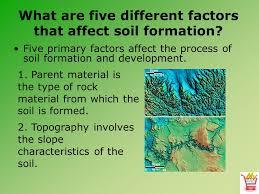Soil is a complex mixture of minerals, organic matter, water, air, and living organisms. It is formed over time through the interaction of five major factors: time, climate, parent material, topography, and organisms.

Time: Soil formation is a slow process that can take thousands or even millions of years. The longer a soil has been forming, the more developed it will be.
Climate: Climate is a major factor in soil formation. The amount of rainfall and temperature will affect the type of vegetation that grows in an area, and the type of vegetation will affect the type of soil that is formed.
Parent material: The parent material is the rock or sediment from which the soil is formed. The type of parent material will affect the chemical and physical properties of the soil.
Topography: Topography, or the shape of the land, can affect the drainage and aeration of the soil. Soils on slopes will tend to be more eroded than soils on flat land.
Organisms: Organisms, such as plants, animals, and microbes, play an important role in soil formation. They help to break down organic matter, add nutrients to the soil, and aerate the soil.
The interaction of these five factors will determine the type of soil that is formed in a particular area. There are many different types of soil, each with its own unique properties. Some soils are good for growing crops, while others are better suited for other uses, such as building construction or recreation.
Here are some examples of different soil types:
Loam: Loam is a well-drained soil that is rich in organic matter. It is a good soil for growing crops.
Sand: Sand is a loose, well-drained soil that is low in organic matter. It is not a good soil for growing crops, but it can be used for building construction or recreation.
Clay: Clay is a heavy, poorly drained soil that is high in organic matter. It is not a good soil for growing crops, but it can be used for making bricks or pottery.
The type of soil in an area can have a significant impact on the environment and the economy. Soils that are good for growing crops can help to feed the world, while soils that are rich in minerals can be used to extract resources. Soils that are well-drained can help to prevent flooding, while soils that are poorly drained can help to store water.
Soil is a valuable resource that should be protected. We can all help to protect soil by reducing erosion, conserving water, and using pesticides and fertilizers wisely.